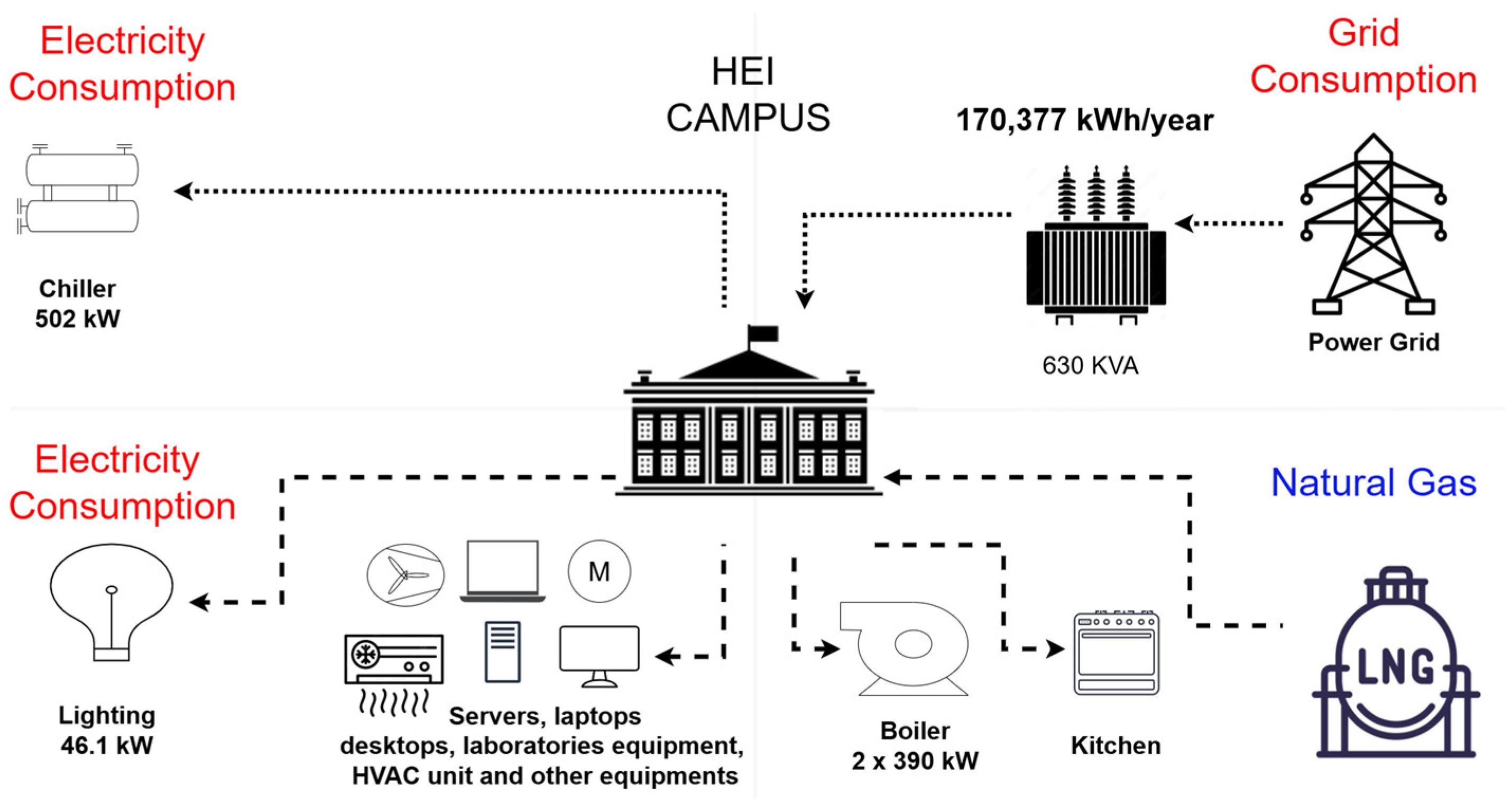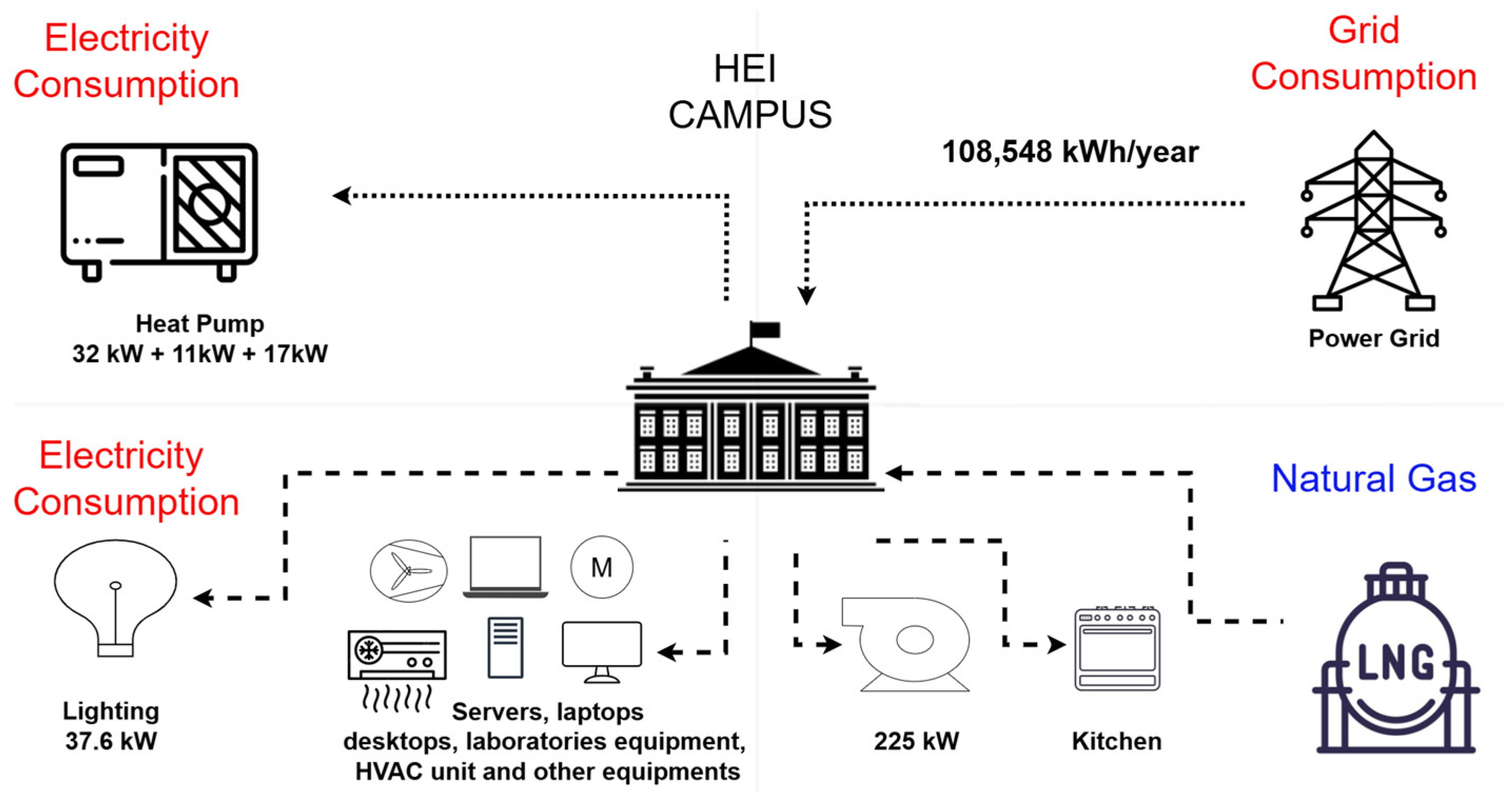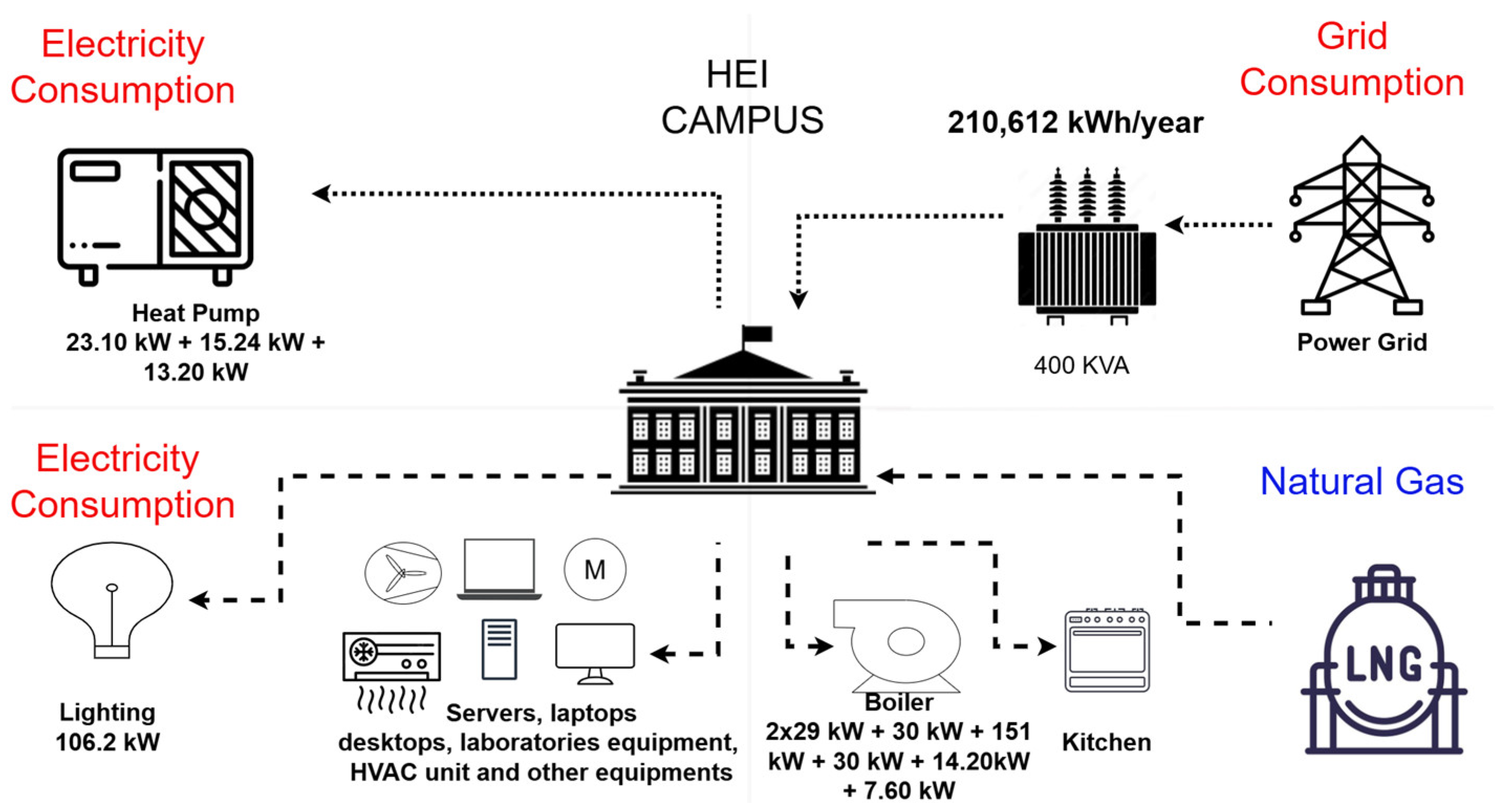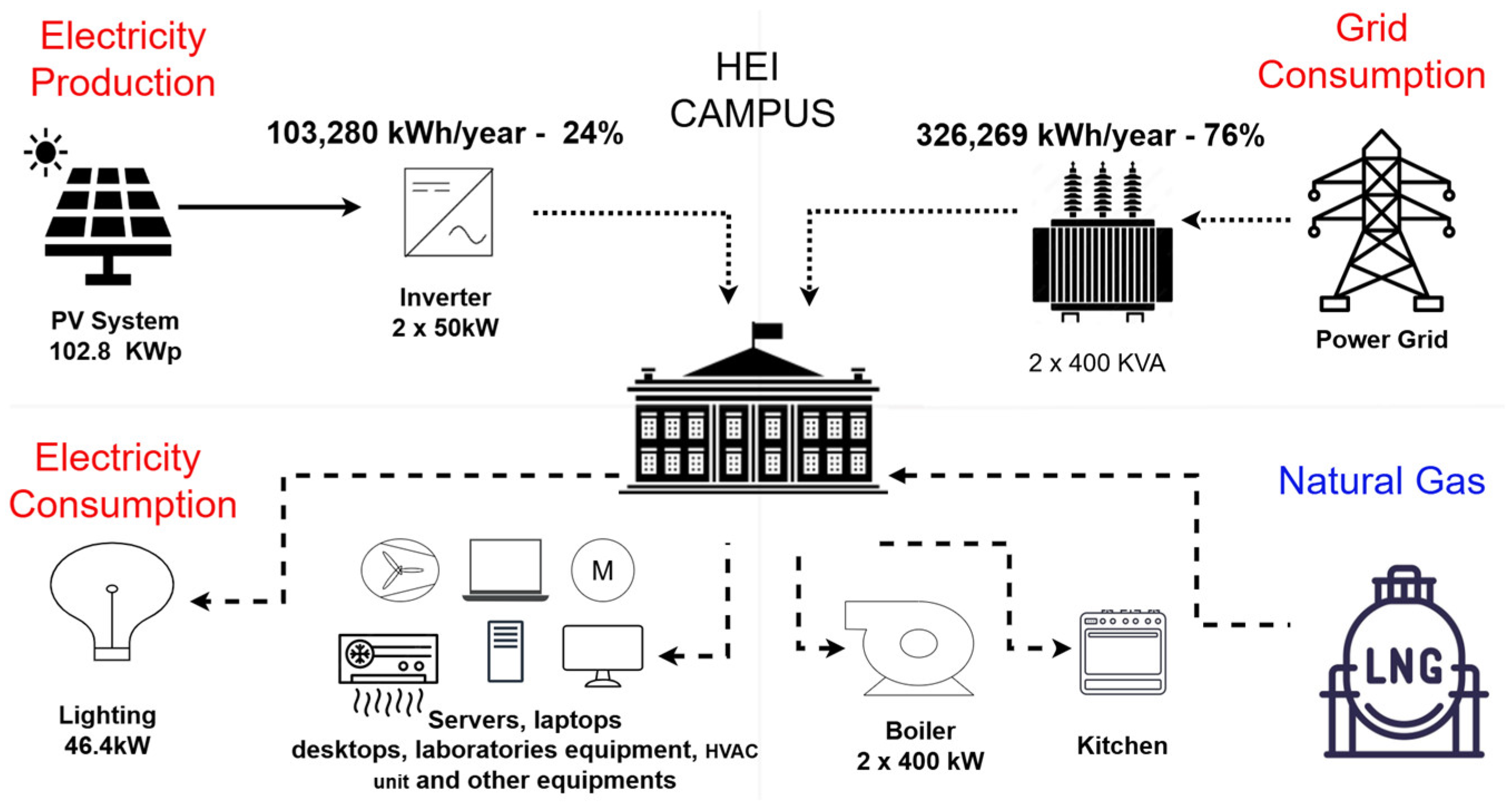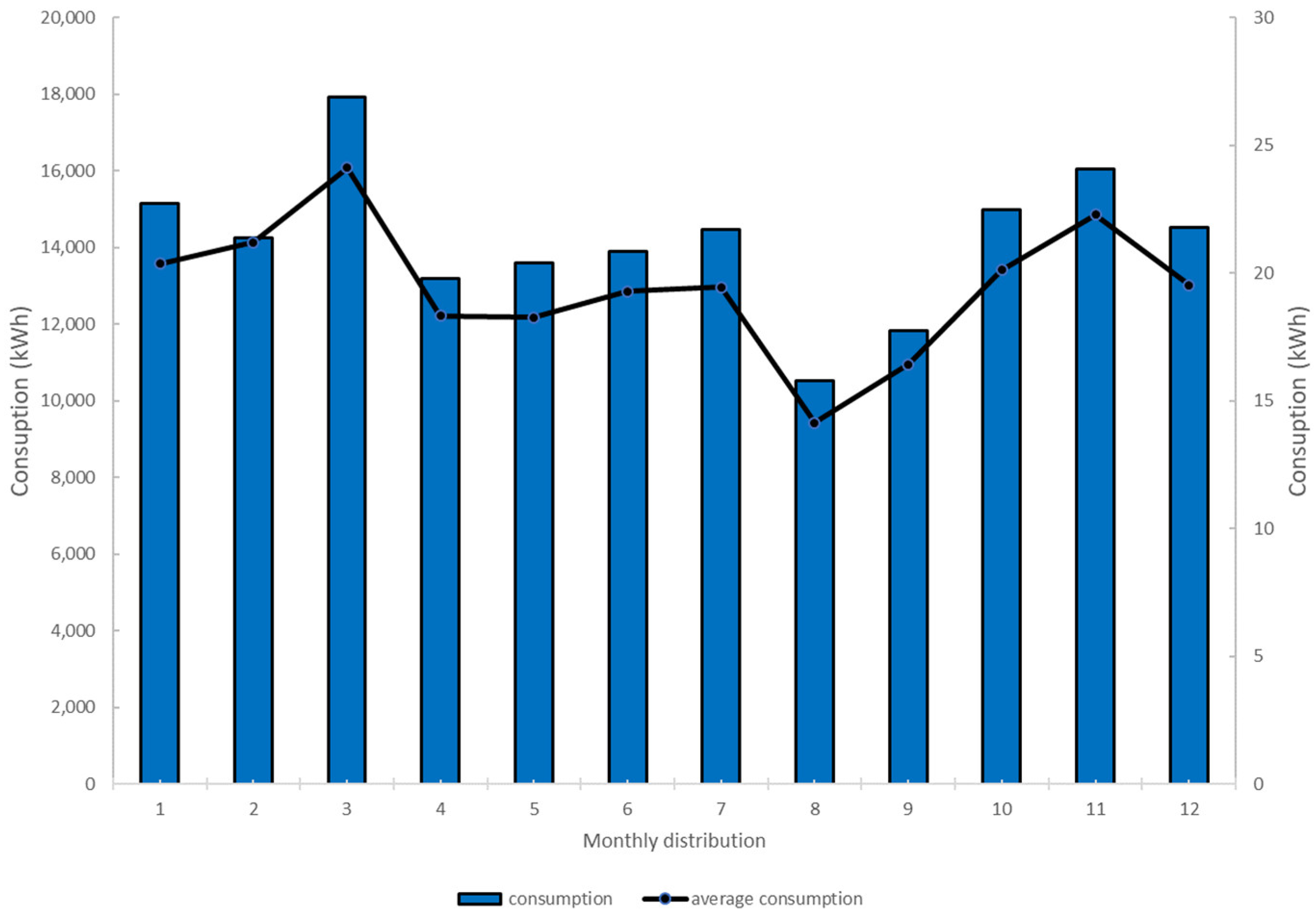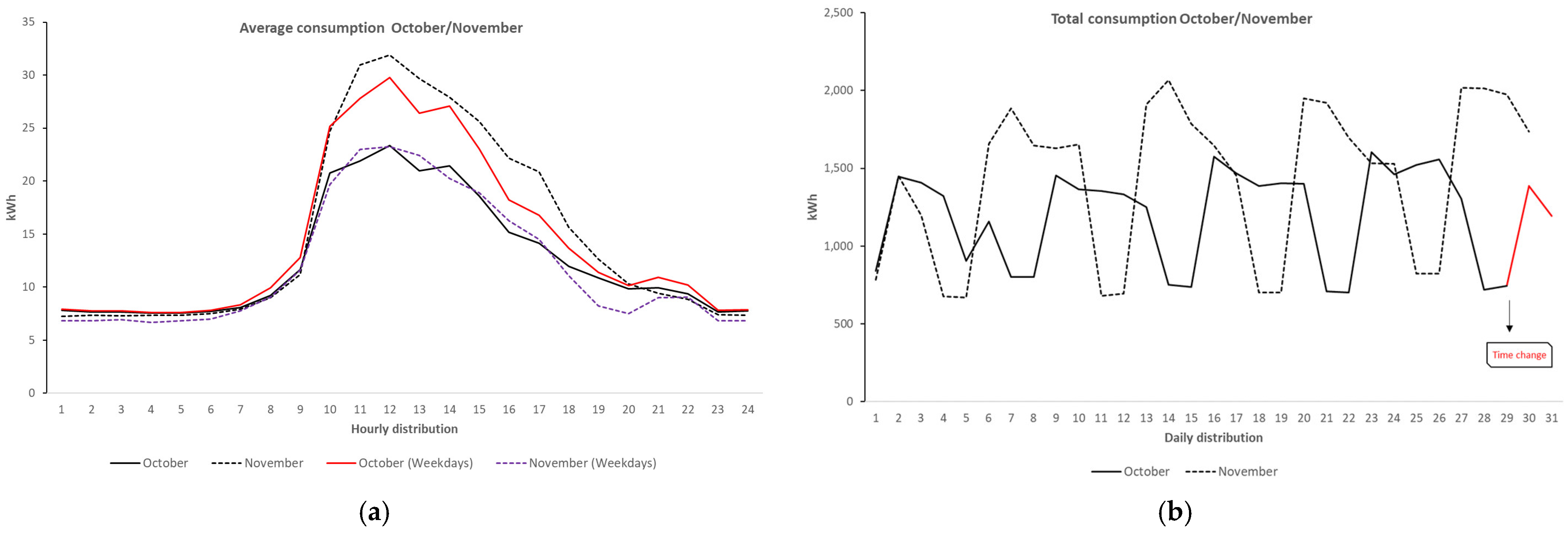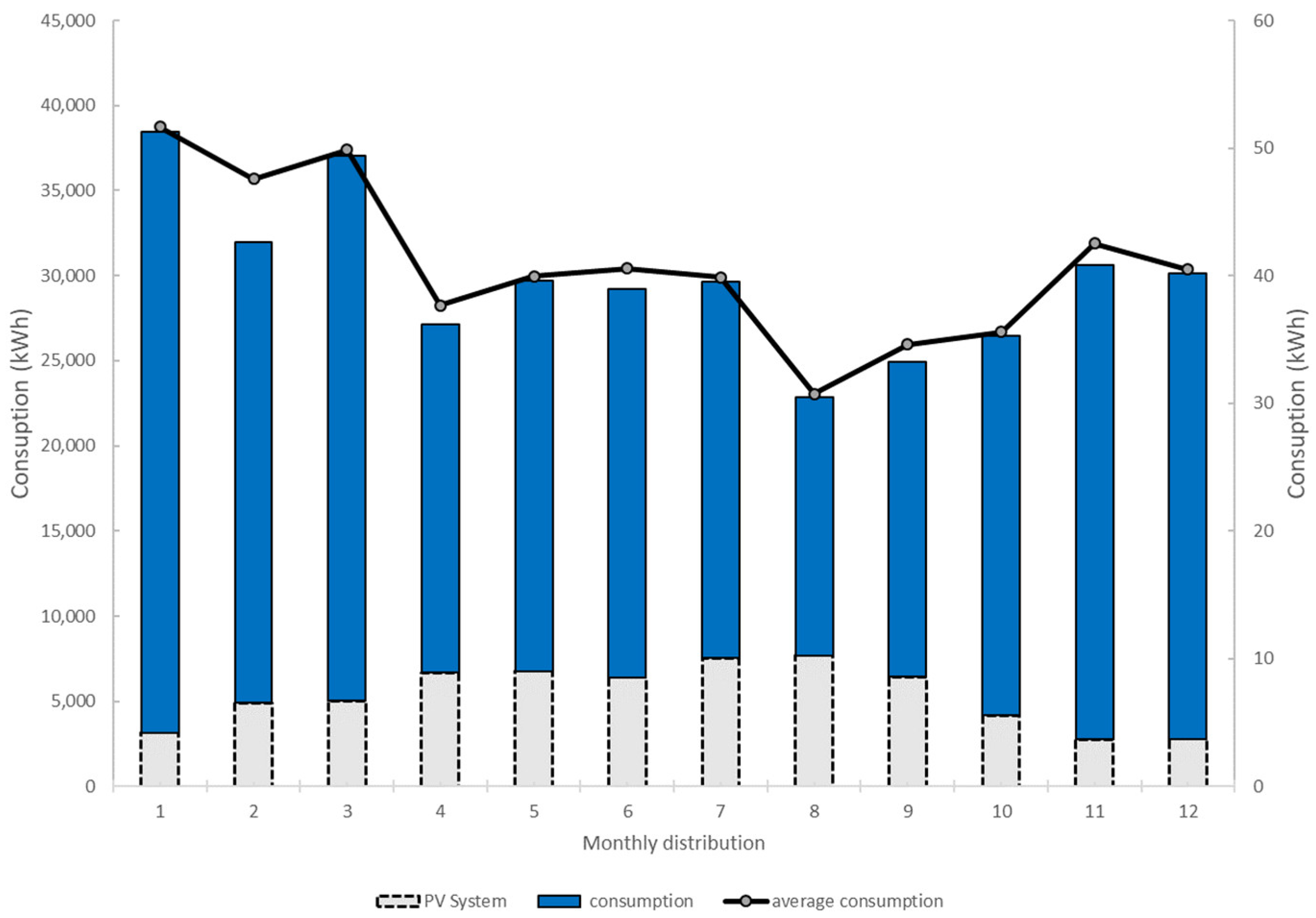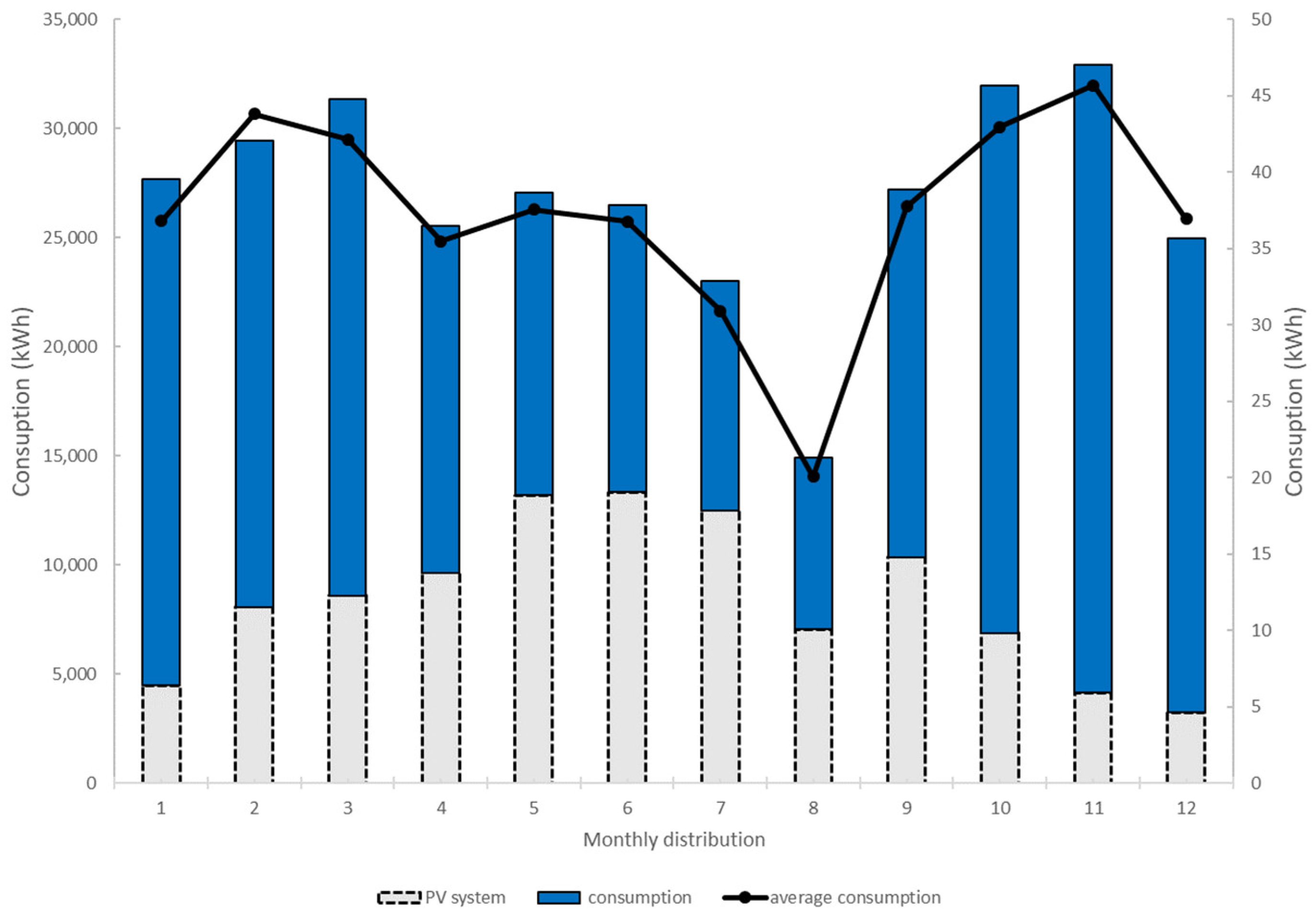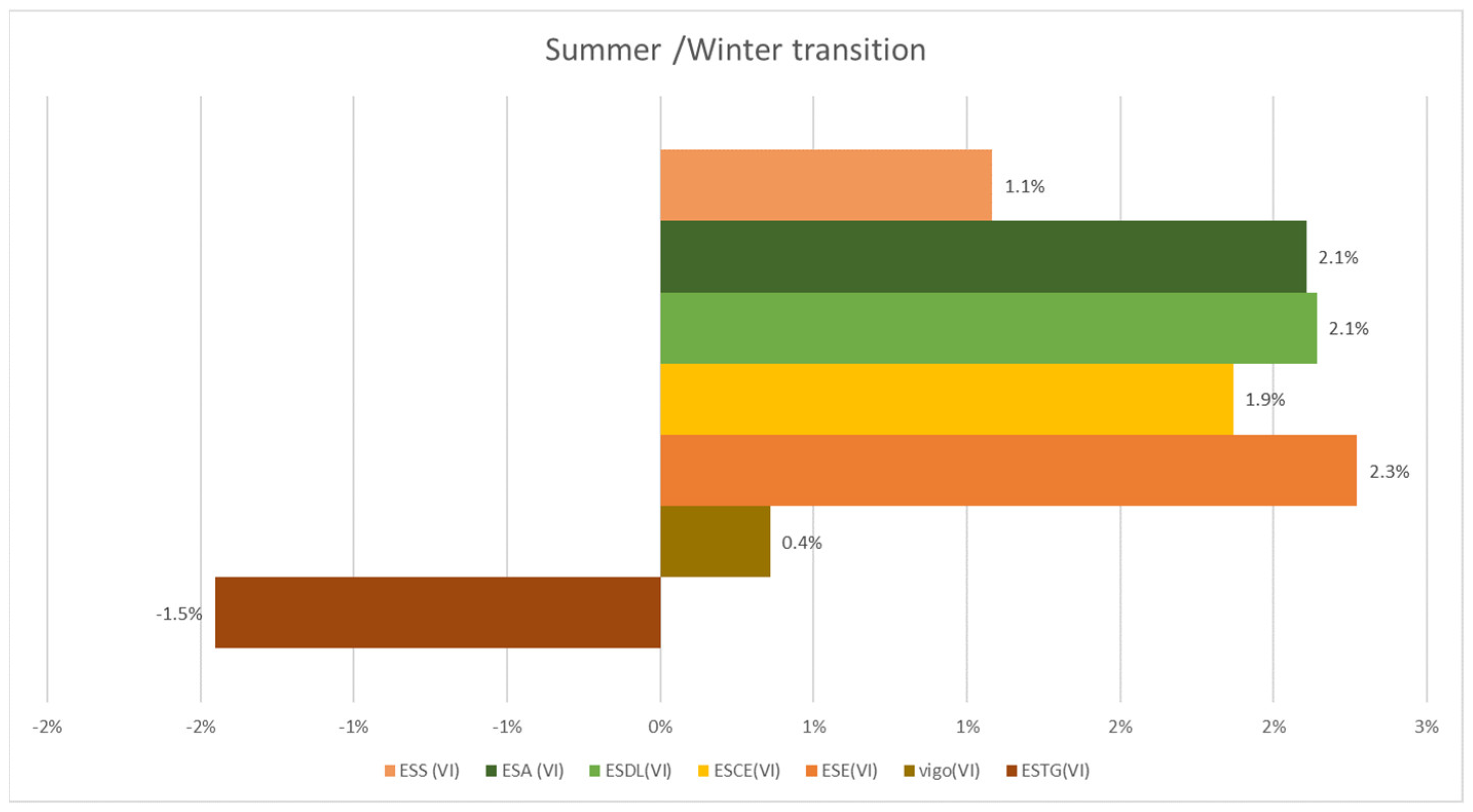This section focuses on the analysis and discussion of the energy consumption results for a set of seven schools over the course of a full year. It examines the variation in consumption throughout the year and assesses the impact of the time changes in March and October due to Daylight Saving Time (DST). The correlation between the results and the energy efficiency of the schools is examined, together with an analysis of the influence of energy demand on the observed results. The impact of the time difference between border regions of Portugal and Spain, both with the same occupancy patterns but in different time zones, is assessed.
4.1. Energy Consumption
4.1.1. School of Business Sciences of Valença, Portugal (ESCEV)
Figure 10 presents the total monthly consumption (kWh) and average hourly consumption per month (kWh) for the School of Business Sciences of Valença, Portugal (ESCEV). The highest energy consumption occurs in March, with another significant peak in November, while the lowest consumption is observed in August, likely due to a reduced academic schedule or summer vacation. The average hourly consumption follows a similar trend, peaking in March and decreasing in August. There is a noticeable drop between March and April, followed by a relatively stable pattern until July. The peaks in March and November may correspond to academic periods with high campus activity, whereas the lower values in August likely reflect summer breaks when fewer students and staff are present. The gradual increase from September to November suggests growing energy use as the academic year resumes. The data indicate a clear seasonal variation in energy consumption, with academic schedules playing a significant role. Strategies for optimizing energy use should focus on reducing consumption during peak months while maintaining efficiency year-round.
Figure 11 presents electricity consumption in March and April 2023 from both a daily (a) and hourly perspective (b). Our objective is to analyze consumption before and after the daylight saving time change. In the first graph (
Figure 11a), which shows daily consumption, there is significant variation throughout the days, with well-defined peaks followed by sharp declines. March, represented by the solid line, exhibits more pronounced fluctuations, while April, indicated by the dashed line, shows a slightly more stable pattern but still with considerable variations. It is worth noting that at the beginning of April, consumption was lower due to the academic break for Easter.
The weekday consumption curve for March exhibits a pronounced and sharp peak between 10:00 AM and 12:00 PM, reaching approximately 62 kWh. This peak is substantially higher than the overall March average, which peaks at just above 50 kWh during the same timeframe. The steep rise beginning around 8:00 AM indicates a significant increase in activity, likely associated with the start of daily operations.
In contrast, the weekday consumption pattern for April also demonstrates a mid-morning increase, with the peak occurring around 12:00 PM and reaching slightly above 40 kWh. While this does represent an increase compared to the general April average, the difference is notably less pronounced than in March. The smaller variation between weekday and all-day consumption in April suggests a more consistent energy usage pattern, with reduced sensitivity to the type of day.
In the second graph (
Figure 11b), which illustrates average hourly consumption, a characteristic pattern is observed throughout the day. During the early morning hours, consumption remains low and stable, starting to increase in the early morning. The peak occurs between 9 AM and 12 PM, followed by a gradual decline throughout the afternoon and evening. When comparing both months, a similar trend is observed, though slight differences in intensity may indicate variations in energy usage patterns.
Figure 12 illustrates electricity consumption trends for October and November 2023 from both an hourly (a) and daily perspective (b).
Figure 12a, representing average hourly consumption, shows a typical daily pattern, where energy usage remains low and stable during the early morning hours before rising sharply in the morning. A peak occurs between 10 AM and 1 PM, followed by a gradual decline throughout the afternoon and evening. The consumption pattern is similar for both months, but November, represented by the dotted line, shows slightly higher peak values compared to October, indicating increased energy demand.
The weekday consumption curve for October shows a clear and pronounced peak between 11:00 AM and 1:00 PM, reaching approximately 55 kWh. This value is notably higher than the overall October average, which peaks at just under 45 kWh during the same period. The steep increase beginning around 8:00 AM suggests a marked rise in activity associated with the start of the workday.
In November, the weekday pattern also demonstrates an elevated mid-morning to early afternoon consumption profile, peaking around 12:00 PM at just above 45 kWh. Compared to the general November trend, this represents a modest increase. However, the difference between weekday and all-day consumption in November is less pronounced than in October.
Figure 12b, representing daily consumption, reveals significant fluctuations throughout both months. Energy usage varies considerably from day to day, likely influenced by factors such as operational activities, weather conditions, or specific demand patterns. Notably, an anomaly is observed between 10 and 12 October. This increased consumption was caused by the use of a chiller for cooling, as temperatures exceeded 30 °C on those days. While both months exhibit similar trends, November appears slightly more stable, whereas October shows more pronounced peaks and drops. Overall, the graphs indicate a consistent pattern of energy usage, with peak demand occurring in the mid-morning to early afternoon and notable daily variations reflecting dynamic consumption behavior.
4.1.2. School of Sports and Leisure of Melgaço, Portugal (ESDLM)
Figure 13 presents the total monthly energy consumption (in kWh) and the average hourly consumption per month for ESDLM. The blue bars represent the total consumption, while the black line indicates the average hourly consumption.
Observing the trend, energy consumption fluctuates throughout the year. The highest total consumption is recorded during the winter months, with peaks in the first and third months. In contrast, the lowest consumption occurs in August, showing a decrease of over 50%. This significant drop is directly related to the school’s summer break, as students are on vacation, and the institution remains closed for 15 days.
Similarly, the average hourly consumption follows a comparable trend. A noticeable decline is observed in February, which coincides with the exam period, when overall energy demand is lower. In December, consumption decreases compared to November, likely due to the Christmas holidays. Towards the end of the year, there is a rebound in energy usage, reflecting an increase in activity after the holiday break.
Figure 14 illustrates the average hourly consumption (left) and total daily consumption (right) for March and April 2023 at ESDLM. The hourly consumption graph represents the average electricity consumption (in kWh) during March and April, distributed throughout the hours of the day. Consumption remains low and relatively constant during the night (between 10 PM and 6 AM). From 7 AM onwards, there is a significant increase, reaching a peak between 10 AM and 12 PM. The peak in March is more pronounced, exceeding 35 kWh, whereas in April, it is slightly above 20 kWh. Additionally, April presents a more stable consumption profile between 10 AM and 2 PM, without the sharp decline observed in March. This reduction in April can be attributed to milder temperatures, leading to a lower need for heating or cooling.
The weekday consumption curve for March demonstrates a distinct and steep peak between 11:00 AM and 1:00 PM, reaching approximately 46 kWh. This is significantly higher than the overall March average, which peaks just above 35 kWh during the same time window. The sharp rise beginning around 9:00 AM suggests a rapid onset of operational or activity-related energy use, typical of a weekday working schedule.
In April, the weekday profile also shows a mid-morning increase, peaking around 12:00 PM at approximately 27 kWh. Compared to the general April curve, which peaks slightly above 21 kWh, the difference is present but more moderate.
The daily consumption graph represents the total electricity consumption (in kWh) for March and April, distributed by day. There is a cyclical pattern, with high-consumption days alternating with lower-consumption days. This behavior is influenced by the academic schedule, as classes take place from Monday to Friday, while on weekends, consumption remains low and constant. At the beginning of April, a noticeable drop in consumption is observed, which coincides with the Easter holiday break, when academic activities are paused.
Overall, the data highlight clear patterns influenced by school schedules. The peak consumption during the day aligns with academic hours, while the variations between March and April suggest seasonal or operational factors affecting energy demand.
In
Figure 15, the first graph (a) illustrates the average hourly energy consumption for October and November 2023, showing a clear peak between 10:00 and 14:00, with November reaching a higher peak than October. As expected, November’s consumption is higher than October’s; however, the facility reports stable consumption between 23:00 and 08:00 in both months. Additionally, in the hourly distribution graph, it is possible to observe low consumption on 5 October, which corresponds with a national holiday.
The weekday consumption profile for October exhibits a sharp increase starting around 9:00 AM, reaching a peak between 11:00 AM and 12:00 PM at approximately 30 kWh. This is notably higher than the overall October average, which peaks during the same timeframe but at a lower value of around 23 kWh.
In contrast, the November profile shows an even more pronounced surge in average consumption, peaking at roughly 33 kWh between 11:00 AM and 12:00 PM. Interestingly, the weekday-specific curve for November peaks at a lower value, just under 24 kWh.
The second graph (b) presents the total daily consumption, revealing a cyclical pattern likely related to weekly variations, with lower consumption on certain days, possibly weekends. This cyclical pattern remains consistent during the winter months. November generally exhibits higher consumption than October, with more pronounced peaks, indicating increased energy demand. Overall, both graphs suggest that energy usage in November was higher than in October, with significant variations in daily and hourly consumption patterns, likely influenced by operational or seasonal factors.
4.1.3. Agrarian School of Ponte de Lima, Portugal (ESAPL)
The graph presented in
Figure 16 illustrates the total monthly electricity consumption and average hourly consumption per month for ESAPL. The blue bars represent the total monthly consumption (kWh), while the black line indicates the average hourly consumption (kWh). Additionally, the contribution from photovoltaic energy is depicted with a dashed line.
This installation is different, as it incorporates a photovoltaic system, which contributes to the total energy supply. However, as observed in the graph, the photovoltaic contribution remains relatively low compared to total consumption, indicating that a substantial portion of the energy demand is still met by external sources.
The data reveal seasonal variations in energy consumption, with higher values recorded in the first quarter of the year (January to March), peaking above 35,000 kWh. A sharp decline is observed in April, followed by a period of relative stability between May and July. The lowest total consumption is noted in August, after which there is a gradual recovery, leading to another peak in November and December. The average hourly consumption follows a similar pattern, with higher values during the beginning and end of the year and a decline in the middle months.
It is important to consider that this campus consists of both an academic building and a student residence, which may influence the observed consumption trends. The academic building’s energy demand is likely driven by class schedules, laboratory activities, and administrative operations, whereas the student residence exhibits a more continuous consumption profile, with possible variations during academic breaks and holiday periods. This distinction may help explain the reduction in consumption during August, when academic activities are minimal and student occupancy is lower.
The presence of the photovoltaic system, despite its relatively small contribution, suggests potential for greater renewable energy integration. Future research could investigate ways to optimize photovoltaic energy use, such as storage solutions or demand-side management strategies, to enhance self-sufficiency and sustainability in ESAPL’s energy consumption.
The graphs presented in
Figure 17 illustrate the average hourly consumption (a) and total daily consumption (b) for March and April 2023 at ESAPL. The solid line represents March, while the dashed line corresponds to April.
In
Figure 17a, the average hourly consumption in March is consistently higher than in April throughout the day. A notable increase in consumption begins at 8:00 AM, peaking between 10:00 AM and 2:00 PM, followed by another rise during dinner hours and a slower decline at night. This trend suggests that energy demand is strongly influenced by the academic building’s activities during the day and by the student residence at night. Additionally, the canteen operations at lunch and dinner contribute to peak consumption periods. April follows a similar pattern but with lower absolute values, potentially due to reduced academic activities or lower student occupancy during holiday periods.
The weekday consumption profile for March exhibits a pronounced peak between 10:00 AM and 12:00 PM, reaching nearly 70 kWh. This is noticeably higher than the general March average (black line), which peaks just above 60 kWh during the same period. The rapid increase beginning around 9:00 AM highlights the onset of intensive weekday operations.
For April, the weekday pattern also demonstrates an increase during the mid-morning to early afternoon period, peaking at approximately 50 kWh around 11:00 AM. Compared to the overall April curve, which peaks closer to 45 kWh, the difference is evident but less substantial than in March.
Figure 17b further supports this observation, showing that the total daily consumption in March is consistently higher than in April. Additionally, March exhibits greater daily consumption variability, with peaks exceeding 1400 kWh on certain days, whereas April displays a more stable curve, with lower fluctuations and values generally below 1200 kWh. A significant drop in consumption is observed on 25 April, corresponding to a national holiday, as well as during the Easter break, when academic activities and the student presence on campus are likely reduced.
These findings align with the seasonal consumption trends identified in
Figure 17, where April showed a reduction in total energy demand compared to March. The decrease in consumption may be attributed to changes in campus occupancy, academic holiday periods, or operational adjustments.
Given that this facility integrates a photovoltaic system, a more detailed analysis could investigate the relationship between solar generation and hourly consumption, as well as potential strategies to optimize self-consumption of renewable energy. Approaches such as load management and energy storage could help reduce reliance on the grid and enhance the overall energy efficiency of the installation.
Figure 18 illustrates the average hourly consumption (a) and total daily consumption (b) for October and November 2023 at ESAPL. The first graph shows the hourly distribution of energy consumption, highlighting a noticeable increase in demand during daytime hours, particularly between 10:00 and 15:00. In November, energy usage appears consistently higher than in October, with a more pronounced peak around midday, indicating seasonal variations or increased activity during this period.
The weekday consumption curve for November displays a distinct and sharp increase starting around 9:00 AM, reaching a peak of nearly 70 kWh by midday. This is significantly higher than the general average for November, which remains below 60 kWh during the same period.
October’s weekday consumption also demonstrates a mid-morning increase, though to a lesser extent. The peak reaches just under 60 kWh, compared to approximately 50 kWh for the overall October average. Despite the visible weekday effect, the differential between weekday and overall values in October is less pronounced than in November.
The second graph presents the total daily consumption across both months. A recurrent pattern can be observed, with alternating peaks and troughs that suggest cyclical consumption trends. November exhibits higher overall energy demand, with more pronounced fluctuations compared to October, likely influenced by operational or environmental factors. These results provide insights into energy consumption behaviors, which can be useful for optimizing energy efficiency and planning future energy supply strategies.
4.1.4. School of Education Sciences of Viana do Castelo, Portugal (ESEVC)
Figure 19 illustrates the total monthly energy consumption and the average hourly consumption per month for ESEVC. The bar chart represents the total energy consumption (kWh) for each month, while the line graph indicates the corresponding average hourly consumption. A clear seasonal trend is observed, with higher consumption levels in the winter months (January, February, and December) and a decline during the summer period, particularly in July and August. This variation is likely influenced by seasonal factors, such as heating demands in winter and reduced activity during summer vacation months. Notably, the school closes for two weeks in August, which contributes to the significant drop in energy consumption during this period. Additionally, a strong correlation between total monthly consumption and average hourly consumption is evident, as the trends in both datasets follow a similar pattern. The peaks in consumption during the colder months suggest a significant dependency on climate-related energy usage, which should be considered for energy efficiency and sustainability planning.
Figure 20 presents the average hourly consumption (a) and total daily consumption (b) for March and April 2023 at ESEVC. The first graph demonstrates the hourly distribution of energy consumption, showing a clear peak in March between 10:00 and 14:00, which is more pronounced than in April. In contrast, April exhibits a more stable consumption pattern throughout the day, with lower overall energy usage compared to March. This suggests variations in operational activity, possibly influenced by differences in school schedules or external factors such as weather conditions.
The weekday consumption profile for March reveals a marked and rapid increase beginning around 9:00 AM, reaching a peak of approximately 60 kWh by midday. This value significantly exceeds the general March average, which peaks near 47 kWh in the same timeframe. In contrast, the weekday profile for April also shows a mid-morning increase, albeit more moderate, peaking at around 35 kWh.
The second graph highlights daily energy consumption trends for both months. March shows higher and more fluctuating consumption levels, whereas April follows a more regular pattern with periodic decreases, likely corresponding to weekends or holidays. These variations may reflect differences in academic schedules, operational demand, or external influences. The data indicate that March experiences higher overall energy demand, reinforcing the need to analyze the impact of academic activities and external conditions on energy consumption patterns.
On campus, they have an academic residence, classroom building, and football field. The graph clearly indicates the period during which the lighting of the football field is used, which is combined with the period of preparation of meals for dinner. The reduction in consumption during the Easter holiday period is noticeable.
The analysis of
Figure 21 reveals significant patterns in both hourly and daily electricity consumption for October and November 2023 at ESEVC. The first graph (a), which depicts the average hourly consumption, shows a clear increase in demand starting at approximately 7:00, peaking between 10:00 and 12:00, and maintaining relatively high levels throughout the afternoon before gradually declining in the evening. Notably, November exhibits slightly higher consumption levels compared to October, particularly during peak hours, suggesting either increased activity or colder temperatures requiring additional energy use. The observed peaks likely correspond to meal production times and the lighting of the football field, contributing to higher consumption during specific periods.
The weekday consumption profile for November displays a marked increase beginning around 9:00 AM, culminating in a pronounced double peak—first between 11:00 AM and 12:00 PM, and again between 7:00 PM and 8:00 PM—both reaching values around 50 kWh. The overall November profile follows a similar trend but with slightly lower intensity, peaking at approximately 45 kWh.
October, in comparison, shows a more moderate pattern. The weekday profile increases steadily from 9:00 AM and plateaus around 11:00 AM, maintaining a level of approximately 40 kWh throughout the afternoon. The overall October curve is consistently lower, peaking just above 35 kWh.
The second graph (b), illustrating total daily consumption, highlights considerable fluctuations across both months. A recurring pattern emerges, where consumption tends to be higher on certain days, likely corresponding to weekdays, while a marked drop is observed on other days, possibly weekends. The impact of the October holiday is also visible, resulting in a significant decrease in consumption on that specific day. November generally shows higher total daily consumption than October, reinforcing the trend observed in the hourly data. The variations between consecutive days suggest dynamic energy usage, potentially influenced by operational schedules, climatic conditions, or institutional activities. These findings indicate the need for further investigation into specific factors influencing consumption patterns, which could be essential for optimizing energy efficiency and implementing demand-side management strategies.
4.1.5. School of Health Sciences of Viana do Castelo, Portugal (ESSVC)
Figure 22 illustrates the total monthly consumption and the average hourly consumption per month at ESEVC. The data reveal a clear seasonal trend, with the highest total consumption observed in the winter months (January, February, November, and December) and the lowest in August. This pattern likely reflects variations in institutional activity, with reduced operations during summer months leading to lower energy demand. Notably, the institution closes for 15 days in August, which significantly contributes to the sharp drop in consumption during that month.
The average hourly consumption, represented by the black line, follows a similar trend, decreasing steadily from January to August before increasing again towards the end of the year. The lowest values occur in August, reflecting the partial closure of the institution. From September onward, both total and average hourly consumption increase, reaching their peak in December, possibly due to extended heating and lighting requirements during colder months.
The PV system’s contribution, shown in the dashed bars, remains relatively constant throughout the year but only covers a fraction of the total energy demand. This suggests that while photovoltaic generation provides some energy savings, additional measures may be required to further optimize consumption, particularly during high-demand months.
Figure 23 presents the average hourly consumption (a) and total daily consumption (b) for March and April 2023 at ESEVC. The first graph (a) shows a clear difference in energy usage patterns between the two months. In March, there is a sharp increase in consumption starting around 7:00, reaching a peak between 9:00 and 12:00, and maintaining high levels until approximately 15:00 before gradually decreasing in the evening. In contrast, April exhibits a lower and more stable consumption pattern throughout the day, with a peak occurring slightly later and at a reduced magnitude compared to March. This suggests that March may have had higher institutional activity or additional energy demands during morning hours.
March (Weekdays) shows a significantly sharper peak between 9 AM and 12 PM, reaching nearly 60 kWh, compared to the general March average, which peaks just above 50 kWh. April (Weekdays) also shows a noticeable increase in the mid-morning to early afternoon period compared to the overall April data, though the differences are smaller than in March.
The second graph (b) illustrates total daily consumption, highlighting significant fluctuations in March, while April presents a more stable daily profile with lower overall consumption. The peaks in March indicate days with considerably higher energy demand, possibly due to specific events, increased occupancy, or operational factors. In contrast, April maintains a more uniform consumption pattern, suggesting reduced variability in institutional activities.
These results indicate that March had higher energy demands, particularly in the morning, whereas April displayed a more balanced and lower consumption trend. This Institution has only classes and does not serve dinners.
Figure 24 presents the average hourly consumption (a) and total daily consumption (b) for October and November 2023 at ESSVC. The left graph (a) illustrates the hourly energy consumption pattern, showing a marked increase in demand starting around 7:00 AM, peaking between 10:00 AM and 12:00 PM, and then gradually declining throughout the afternoon and evening. Notably, November exhibits slightly higher consumption during peak hours compared to October, suggesting a seasonal effect or increased activity during this period.
The weekday consumption curve for November reveals a sharp and early morning increase starting around 7:00 AM, peaking steeply between 10:00 AM and 11:00 AM at approximately 47 kWh. This peak significantly exceeds the overall November average, which reaches a lower maximum of around 38 kWh during the same time window.
In comparison, October presents a more moderate profile. The weekday curve shows a rapid increase beginning after 8:00 AM, peaking between 11:00 AM and 12:00 PM at just above 34 kWh. This is higher than the overall October curve, which plateaus at approximately 30 kWh during midday.
The right graph (b) displays the total daily energy consumption for both months. The data reveal significant day-to-day fluctuations, with peaks observed around the middle and end of the month, particularly in November. This variability may be attributed to operational changes, external temperature influences, or specific events that led to increased energy demand. Additionally, the general trend suggests that November had higher overall consumption than October, aligning with the hourly distribution analysis.
4.1.6. School of Technology and Management of Viana do Castelo, Portugal (ESTGVC)
Figure 25 illustrates the total monthly energy consumption and the average hourly consumption per month for ESTGVC, comparing data from March and April. The left graph (a) displays the average hourly energy consumption, showing a distinct increase in demand from early morning onwards, peaking between 9:00 AM and 12:00 PM. The consumption then remains relatively stable in the afternoon before gradually declining in the evening. Notably, March exhibits higher peak consumption levels compared to April, suggesting a possible decrease in energy demand during the latter month. This variation may be linked to external factors such as academic schedules, temperature differences, or operational adjustments within the facility. The right graph (b) presents the total daily energy consumption for both months, revealing significant fluctuations in demand across individual days. March shows higher peaks on several days compared to April, reinforcing the trend observed in the hourly distribution. The variability observed in both months suggests that energy consumption is influenced by specific operational or external conditions, leading to periodic spikes in demand. It is also important to note that ESTGVC closes for 15 days in August, which likely results in a significant reduction in energy consumption during that period.
The analysis of
Figure 26, which presents the average hourly consumption (a) and total daily consumption (b) for March and April 2023 at ESTGVC, reveals significant variations in energy usage patterns. The first graph (a) indicates a marked increase in electricity demand during working hours, particularly from 8 AM to 2 PM, followed by a gradual decline in the evening. This pattern aligns with the operational schedule of the institution, which is the largest school within IPVC, hosting daytime and evening classes and providing lunch and dinner services. The higher consumption in March compared to April suggests seasonal or academic calendar influences, possibly linked to variations in class schedules or occupancy levels.
The weekday consumption profile for March reveals a pronounced and rapid increase beginning around 9:00 AM, culminating in a distinct peak at approximately 11:00 AM, reaching just above 105 kWh. This is substantially higher than the overall March average, which peaks at around 85 kWh during the same timeframe.
In April, the weekday curve also demonstrates a steep rise starting at 9:00 AM, with a peak of roughly 90 kWh around 12:00 PM. This contrasts with the overall April profile, which peaks lower, around 75 kWh.
The second graph (b), illustrating total daily consumption, presents a highly fluctuating pattern, reflecting variations in daily energy needs. The significant peaks and troughs suggest differences in activity levels on specific days, potentially influenced by the presence of exams, special events, or variations in student and staff attendance. March generally exhibits higher overall consumption than April, reinforcing the possibility of reduced activities or occupancy changes.
The analysis of
Figure 27, which presents the average hourly consumption (a) and total daily consumption (b) for October and November 2023 at ESTGVC, highlights significant variations in energy usage patterns influenced by specific events. In graph (a), the hourly consumption follows a similar trend for both months, with a pronounced increase from 8 AM, peaking around noon, and gradually declining in the evening. However, October exhibits slightly higher values, which can be attributed to various organized events during this period, including the Sustainable Campus Conference, student festivities during nighttime hours, and other academic activities.
The weekday consumption profile for October shows a sharp and rapid increase beginning around 9:00 AM, peaking near 1:00 PM at just under 115 kWh. This level is significantly higher than the overall October average, which reaches a lower peak of approximately 95 kWh during the same period.
In November, the weekday profile also exhibits a marked rise starting around 9:00 AM, with a peak of about 105 kWh around 1:00 PM. This contrasts with the overall November average, which peaks at around 90 kWh.
In graph (b), daily consumption shows a fluctuating pattern, with October displaying higher overall consumption than November. This trend is unique among the studied entities, as all others exhibited higher energy usage in November. The increased activity in October explains this deviation, reinforcing the impact of events on electricity demand. Additionally, the significant drop in consumption observed on November 5 clearly marks a public holiday, further confirming the correlation between academic operations and energy usage patterns.
4.1.7. School of Mines and Energy, University of Vigo, Spain (UVEM)
The analysis of
Figure 28, which presents the total monthly consumption and average hourly consumption per month for UVEM, reveals distinct seasonal variations in energy demand. The blue bars indicate total monthly consumption, while the black line represents the average hourly consumption. The data show higher energy consumption during the winter months (January, February, November, and December), with peaks in February and November, likely due to increased heating demands and operational intensity during these periods. A notable decline in energy consumption is observed during the summer months, particularly in August, which corresponds to a period of reduced activity due to academic breaks or lower occupancy levels. This trend is further supported by the simultaneous reduction in both total and average hourly consumption. The presence of a photovoltaic (PV) system, represented by the dashed bars, highlights the contribution of renewable energy to overall consumption, which remains relatively stable across the months.
The data underscore the importance of seasonal influences on energy consumption, demonstrating how institutional activity levels and climatic conditions impact overall demand. Understanding these variations is crucial for implementing effective energy management strategies, optimizing PV system utilization, and improving energy efficiency in educational and research facilities.
Figure 29 presents the average hourly consumption (a) and total daily consumption (b) for March and April 2023 at UVEM. The first graph shows a clear diurnal pattern, with energy consumption increasing sharply from around 6 to 7 AM, reaching its peak between 10 AM and 3 PM, and then gradually decreasing after 5 PM. This trend suggests a strong correlation with human activity, likely corresponding to operational hours. The comparison between March and April indicates similar overall behavior, although April exhibits slightly lower peak values, which could be attributed to seasonal variations, changes in operational schedules, or energy efficiency measures.
The weekday consumption profile for March exhibits a rapid increase starting around 7:00 AM, reaching a sharp and sustained peak of approximately 95–100 kWh between 10:00 AM and 1:00 PM. This is significantly higher than the overall March average, which peaks lower, at around 75 kWh during the same period.
In April, the weekday profile also shows a notable rise beginning at 7:00 AM, peaking around 11:00 AM to 12:00 PM at roughly 80 kWh. This contrasts with the overall April average, which peaks at approximately 60 kWh.
The second graph highlights the daily energy consumption, revealing significant fluctuations, particularly in March, where sharp peaks and drops suggest intermittent high-consumption events or irregular operational patterns. April, in contrast, presents a more stable trend with fewer extreme variations, indicating a potentially different load management approach or altered usage patterns. Despite these variations, the overall energy consumption for both months appears comparable. These trends provide valuable insights into energy usage at UVEM, emphasizing the importance of understanding load dynamics for potential optimization. Further analysis could explore external influencing factors such as temperature, occupancy, or operational constraints to identify strategies for improved energy efficiency and demand-side management.
Figure 30 presents the average hourly consumption (a) and total daily consumption (b) for October and November 2023 at UVEM. The first graph demonstrates a well-defined diurnal pattern, with energy consumption remaining low during early morning hours, followed by a sharp increase starting around 6–7 AM. The peak consumption occurs between 10 AM and 3 PM, after which there is a gradual decline. This trend suggests that energy use is primarily driven by daytime activities, likely associated with operational hours. The curves for October and November exhibit similar behavior, with November showing slightly higher values during peak hours, possibly due to increased demand or variations in environmental conditions affecting energy usage.
The weekday consumption profile for October reveals a pronounced and rapid increase starting at around 6:00 AM, with a sharp climb between 8:00 and 10:00 AM, reaching a peak of approximately 95 kWh by 12:00 PM. This value is noticeably higher than the overall October average, which peaks more modestly at around 75 kWh.
In November, the weekday profile shows an even steeper early morning ramp-up, beginning around 6:00 AM and peaking between 11:00 AM and 1:00 PM at just above 100 kWh. This contrasts with the overall November average, which peaks lower, around 80 kWh.
The second graph depicts daily energy consumption and reveals a periodic pattern with alternating high and low values. This fluctuation suggests a structured operational cycle, potentially influenced by weekdays and weekends or scheduled energy-intensive activities. The overall magnitude of consumption appears relatively stable across both months, though November exhibits a more consistent pattern with fewer extreme drops compared to October. This stability may indicate improved load distribution or fewer disruptions in energy usage.
4.1.8. Analysis of Energy Consumption with a Comparison to Sunlight Hours
To determine the hours of sunlight, sunrise, and sunset, times for the year 2023 were collected based on the region’s coordinates (sourced from
https://www.sunrise-and-sunset.com, accessed on 19 December 2024). This information was then organized by month, and the monthly averages for sunrise and sunset times were calculated. The same method was applied to compute the average day length for each month.
Table 3 presents the variation in day length and monthly energy consumption in HEIs, considering a set of variables associated with sunrise and sunset times, day length, and the monthly energy consumption of the Higher Education Institutions (HEIs) under study. As expected, day length follows a seasonal pattern, being shorter in winter months—approximately 9 h in December and January—and longer during the summer, reaching around 15 h in June. Variations in energy consumption throughout the year reveal significant fluctuations, resulting from both academic dynamics, marked by the presence or absence of teaching activities, and climatic factors, particularly ambient temperature. In general, energy consumption increases during colder months, which can be attributed to the intensified use of heating systems in university facilities. A sharp decrease in consumption is observed in August, a period corresponding to the academic break and a high incidence of staff vacations. On the other hand, an increase in energy consumption is recorded in March in most institutions, reflecting the resumption of academic activities after the break for exams at the end of January and throughout February. In this context, April and August represent evident transition periods in the energy consumption pattern, reflecting the influence of holiday periods and changes in the dynamics of academic activities. These results highlight the importance of considering seasonality and the organization of the academic calendar in the management of energy efficiency in higher education institutions.
Table 4 presents the monthly percentage variations in energy consumption across various Higher Education Institutions (HEIs), enabling a comparative analysis of consumption trends throughout the year. Each row represents a month, while each column corresponds to an institution, highlighting consumption patterns and variations associated with academic activity and seasonal factors. Positive values in the table indicate an increase in energy consumption compared to the previous month, whereas negative values reflect a reduction. Significant fluctuations are observed, such as the +45% increase recorded at UVEM, coinciding with the start of the academic year after the summer break, and sharp reductions, such as the −58% at ESS, reflecting a month in which the institution remains closed. Synchronized fluctuation patterns are evident during certain periods of the year. In April and August, all institutions show sharp negative variations, corresponding to academic breaks that lead to reduced activity and, consequently, lower energy consumption. However, inter-institutional discrepancies are also noted, particularly when UVEM reports a +6% increase, while other institutions register decreases. This divergence is due to differences in the academic calendar between Portugal and Spain. April stands out for pronounced negative variations (e.g., ESCEV −36%, ESEVC −38%, ESAPL −37%, ESDLM −38%), attributable to the Easter holiday period. In August, even steeper declines are recorded (ESSVC −58%, UVEM −54%, ESDLM −43%), associated with the summer holidays, which result in an almost total suspension of academic and administrative activities. In contrast, September exhibits a significant increase in consumption (UVEM +45%, ESDLM +34%, ESTGVC +30%), reflecting the resumption of academic activities and increased building occupancy.
4.1.9. Comparison of Energy Consumption Before and After the Time Change
Seasonal time changes occurred twice during 2023, on 26 March and 29 October. To assess their impact on energy consumption, data from periods before and after each transition were analyzed by day of the week. Percentage variations in energy consumption were calculated, followed by the determination of average values. A comparative analysis between the two periods—corresponding to summer and winter time—was conducted for each campus using an independent samples
t-test. The resulting
p-values are reported in
Table 5, with statistical significance considered at
p < 0.05.
Table 6 presents the descriptive statistics of performance variations across different institutions during the two seasonal transitions: Winter to Summer (WS) and Summer to Winter (SW). For each institution and period, the table includes the mean percentage change (Average), standard deviation (SD), sample size (n), significance level (α), margin of error for the 95% confidence interval (CI), and the corresponding lower and upper bounds of the 95% CI.
Table 7 provides a comparative analysis of the average percentage performance change observed across institutions during the two seasonal transitions: Winter to Summer (WS) and Summer to Winter (SW). For each institution, the table reports the mean percentage change for both transitions, along with the corresponding 95% confidence intervals (CIs) and the
p-value associated with the difference between them. Negative average values indicate a reduction in energy consumption, while positive values represent an increase. Confidence intervals that do not include zero suggest that the average change is statistically significant. The
p-values further support the assessment of whether the observed differences between WS and SW transitions are significant at conventional thresholds (typically
p < 0.05). This analysis enables the identification of institutions with performance patterns significantly affected by seasonal time changes. Statistically significant differences (
p < 0.05) were observed in institutions such as ESE, ESCE, ESDL, ESA, and ESS, whereas ESTG and VIGO did not exhibit significant seasonal variation.
Figure 31 presents a horizontal bar chart illustrating the variation in energy consumption across Higher Education Institutions (HEIs) during the transition from winter time to summer time. The analysis considers data from the week before and the week after the time change, which occurred on 26 March 2023, ensuring comparability by evaluating the same weekdays in both periods. The results reveal an overall trend of reduced energy consumption, with a general average decrease of −1.7%, indicating a moderate impact of the time change. With the exception of ESDL, all analyzed institutions recorded a decline, suggesting that the transition to summer time positively influences energy efficiency. The most significant reduction was observed at ESA (−4.0%), followed by ESS (−3.4%) and ESE (−2.1%). The University of Vigo reported a variation of −1.4%, while ESTG and ESCE registered smaller reductions of −1.0% and −0.4%, respectively. On the other hand, ESDL stands out as the only institution with a slight increase in consumption (+0.1%), which may be associated with specific energy demand characteristics or operational patterns during the analyzed period. The prevailing trend of reduced consumption reinforces the correlation between the shift to summer time and the decrease in energy demand in HEIs.
Figure 32 presents a horizontal bar chart analyzing the variation in energy consumption during the transition from summer time to winter time across various Higher Education Institutions (HEIs). The analysis is based on data from the week before and the week after the time change, which occurred on 29 October 2023, ensuring comparability by evaluating the same weekdays in both periods. The global average stands at +1.9%, indicating a moderate increase in energy consumption following the time change. With the exception of ESTG, all institutions recorded an increase, reflecting the impact of the transition to winter time on higher energy consumption. The highest increase was observed at ESE (+2.3%), followed by ESA and ESDL, both at +2.1%. The University of Vigo registered a more modest rise of +0.4%, while ESS showed a variation of +1.1%, close to the average. ESTG stands out as the only institution with a negative variation (−1.5%), a trend that may be explained by a high number of events held in the week prior to the time change, leading to atypically high energy consumption before the transition. The predominantly positive trend in the observed variations reinforces the correlation between the shift to winter time and increased energy consumption, suggesting that the reduction in natural daylight at the end of the day results in greater reliance on artificial lighting and potentially higher use of heating systems.


